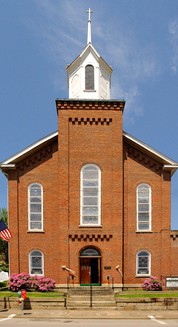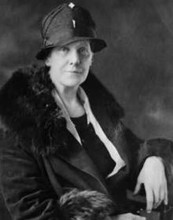International Mother's Day Shrine
Introduction
Author-Uploaded Audio
Listen to a narration of this entry's description by Kathleen Thompson.
Text-to-speech Audio
Images
Andrew's Methodist Church

Anna Jarvis began the tradition of Mother’s Day and worked to preserve the non-commercial nature of the holiday.

Backstory and Context
Author-Uploaded Audio
Listen to a narration of this entry's description by Kathleen Thompson.
Text-to-speech Audio
Anna Marie Jarvis was born on May 1, 1864, to parents Granville and Ann Jarvis in Webster, West Virginia. Ann Jarvis was a very talented and caring woman who was known to ensure the well-being of those around her. During the Civil War, she had worked as a nurse and sought to promote better sanitation which instilled better conditions of life and saved several thousands of lives. Even after the war concluded, Ann Jarvis strove to ensure people lived in proper conditions and inspired community and family values within her town.
Anna Jarvis focused highly on family ties and bonds and was very close to her mother. On May 9, 1905, her mother passed away. Two years passed when Anna thought of a way to commemorate her mother. She held a small memorial party at her home in honor of her mother’s life. It was at this party that she announced to her friends her idea to honor mothers by creating a day reserved for honoring mothers everywhere. It would become a national celebration to show appreciation for mothers, a Mother’s Day.
A year later, Anna wrote to Mr. Loar, the Superintendent of Andrews Methodist Church. Her mother had served the church by teaching Sunday School classes there for twenty years. She expressed to the Superintendent her idea to honor mothers and specifically to celebrate it in honor of her mother. Mr. Loar was elated by the idea and agreed to the notion. On May 10, 1908, the first Mother’s Day was celebrated in the church. Anna formulated ideas that would also go into the Mother’s Day holiday. She incorporated a white carnation to symbolize the celebration.
Anna’s idea began to be recognized far and wide. William E. Glasscock established the first state-wide celebration of the holiday on April 26, 1910. In 1912, Anna was recognized as the founder of Mother’s Day. The United States’ Congress officially developed Mother’s Day as the second Sunday in May. Woodrow Wilson signed the resolution for this holiday to be recognized in 1914.
Since its creation in 1908, Andrew’s Methodist Church has observed this holiday. The building itself is registered in the National Register of Historic Places. It was built in 1873 in Grafton, West Virginia.
The Andrew's Methodist Church was known as the "mother church" and was constructed in 1873. It's architecture is that of Romanesque and was constructed by Phillips and Anderson.
By the third call for a Mother's Day Celebration in 1909, 45 states, Puerto Rico, Hawaii, Canada, and Mexico participated in the celebration. Adoption of the holiday surprised Anna who states, "Where it will end must be left for the future to tell. That it will girdle the globe seems now certain."
Sources
"The Founding of Mother’s Day." International Mothers Day Shrine. Accessed 15 Oct. 2014.
Taylor, Gina. Mother’s Day: A Tradition Rooted in Service. West Virginia University. Accessed May 14, 2017. http://fh.ext.wvu.edu/r/download/221529.
